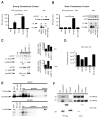A bicistronic MAVS transcript highlights a class of truncated variants in antiviral immunity
- PMID: 24529381
- PMCID: PMC3959641
- DOI: 10.1016/j.cell.2014.01.021
A bicistronic MAVS transcript highlights a class of truncated variants in antiviral immunity
Abstract
Bacterial and viral mRNAs are often polycistronic. Akin to alternative splicing, alternative translation of polycistronic messages is a mechanism to generate protein diversity and regulate gene function. Although a few examples exist, the use of polycistronic messages in mammalian cells is not widely appreciated. Here we report an example of alternative translation as a means of regulating innate immune signaling. MAVS, a regulator of antiviral innate immunity, is expressed from a bicistronic mRNA encoding a second protein, miniMAVS. This truncated variant interferes with interferon production induced by full-length MAVS, whereas both proteins positively regulate cell death. To identify other polycistronic messages, we carried out genome-wide ribosomal profiling and identified a class of antiviral truncated variants. This study therefore reveals the existence of a functionally important bicistronic antiviral mRNA and suggests a widespread role for polycistronic mRNAs in the innate immune system.
Copyright © 2014 Elsevier Inc. All rights reserved.
Figures






Comment in
-
miniMAVS, You Complete Me!Cell. 2014 Feb 13;156(4):629-30. doi: 10.1016/j.cell.2014.01.045. Cell. 2014. PMID: 24529369 Free PMC article.
-
Alternative translation initiation in immunity: MAVS learns new tricks.Trends Immunol. 2014 May;35(5):188-9. doi: 10.1016/j.it.2014.03.005. Epub 2014 Mar 28. Trends Immunol. 2014. PMID: 24685172 Free PMC article.
References
-
- Alberts B. Molecular biology of the cell. 5. New York: Garland Science; 2008.
-
- Chawla-Sarkar M, Lindner DJ, Liu YF, Williams BR, Sen GC, Silverman RH, Borden EC. Apoptosis and interferons: role of interferon-stimulated genes as mediators of apoptosis. Apoptosis. 2003;8:237–249. - PubMed
Publication types
MeSH terms
Substances
Grants and funding
LinkOut - more resources
Full Text Sources
Other Literature Sources
Research Materials
Miscellaneous

